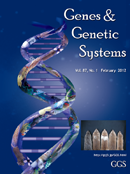
影响因子:0.870
ISSN:1341-7568
出版社:Genetics Society of Japan
出版地:Mishima
出版国家:Japan
刊期:双月刊
创刊时间:1996
语种:英文
审稿周期:>12周,或约稿
中科院分区:4
投稿命中率:命中率约30.90%容易
国外数据收录:IMIM
中国收录文章数:0
5年影响因子:1.349
研究领域:遗传学
期刊介绍:
Influenza A virus continues to pose a threat to public health. Since this virus can evolve escape mutants rapidly, it is desirable to predict the antigenic evolution for developing effective vaccines. Although empirical methods have been proposed and reported to predict the antigenic evolution more or less accurately, they did not provide much insight into the effects of unobserved mutations and the mechanisms of antigenic evolution. Here a theoretical method was introduced to predict the antigenic evolution of H3N2 human influenza A virus by evaluating de novo mutations through estimating the antigenic distance. The antigenic distance defined with the hemagglutination inhibition (HI) titer was estimated with antigenic models taking into account the volume, isoelectric point, relative solvent accessibility, and distances from receptor-binding sites (RBS) and N-linked glycosylation sites (NGS) for amino acids in hemagglutinin 1 (HA1). When the best model with the optimized parameter values was used to predict the antigenic evolution for the dominant strains, the prediction accuracy was relatively low. However, there appeared to be an overall tendency that the amino acid sites with larger potential net effect on antigenicity were more likely to evolve and the amino acid changes with larger potential effect were more likely to take place, suggesting that natural selection may operate to enhance the antigenic evolution of H3N2 human influenza A virus.
| 同领域期刊名称 | 影响因子 |


